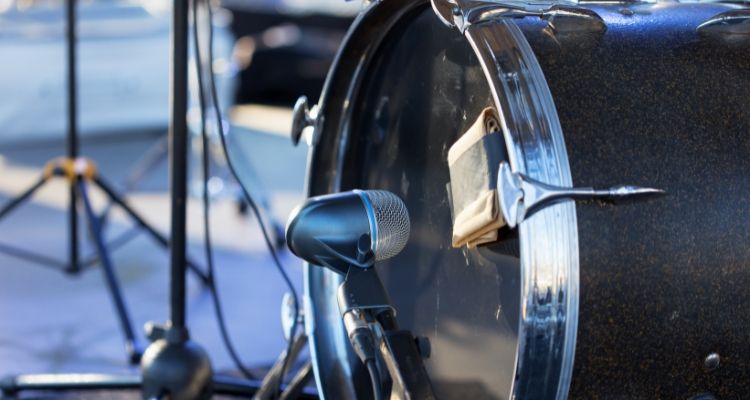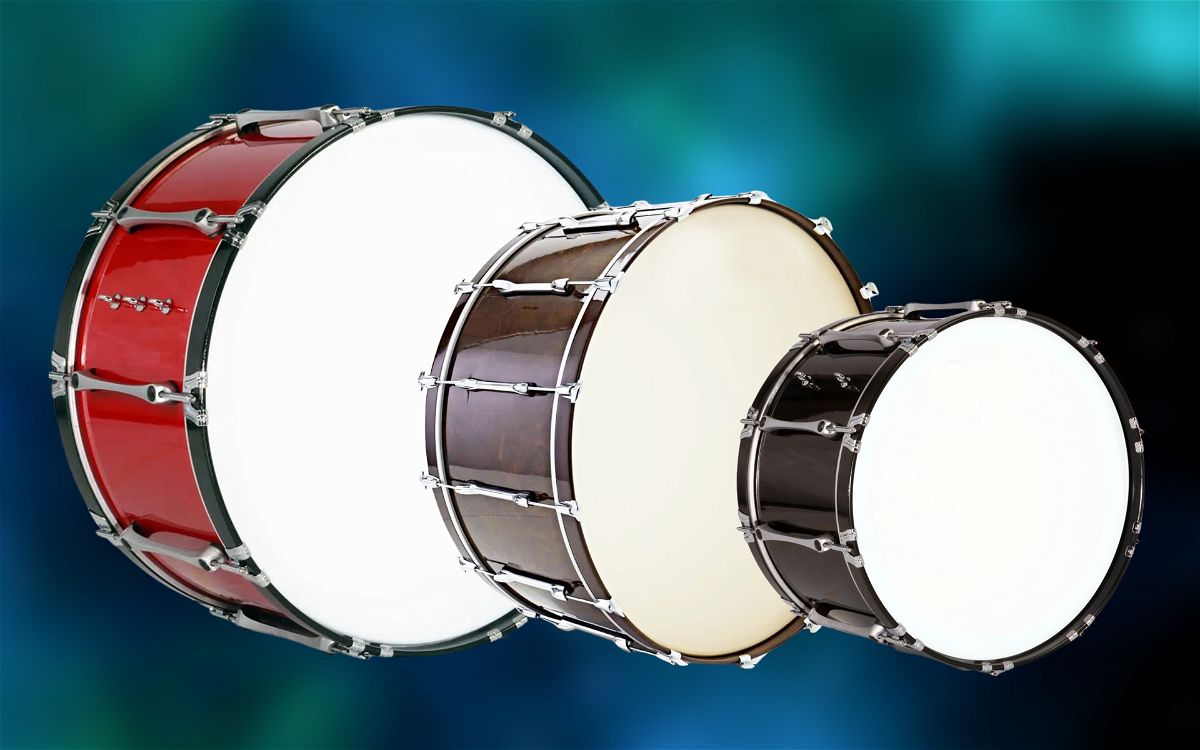One of the most vital decisions to make when picking a drum set is what bass drum size you want. While all drums come in different shapes and sizes, I’ve realized over time that the size of your kick drum makes the most difference.
It can completely determine the overall sound of your drum kit, and certain bass drum shells lend well to specific drumming styles.
In this guide, I’m going to highlight all the qualities of each bass drum shell size. I’ll mention how they sound, and I’ll discuss which environments they work best in.
Contents
Different Kick Drum Sizes
14” Bass Drum
A 14” bass drum is realistically the smallest kind of bass drum you can get. It’s not common, but there are a few kits out there that offer this.
I remember playing on a Tama Club-JAM kit with a bass drum this small, and it was quite a unique experience.
You get a lot of attack and bite, but you miss all the low-end oomph that bass drums are known to have. The shell also wobbles quite a bit when you play, as the size is disproportionate to the force coming from the bass drum beater.
I’d only recommend using a bass drum this size for a busking travel kit. I can’t think of many other reasons to use one.
16” Bass Drum
16” bass drums are incredibly popular on compact drum kits. This is the smallest bass drum size that I would happily recommend, as you get some great qualities.
It’s the same size as most floor toms, so you’re able to get deep tones when you tune the drum low. You also get an aggressive attack that cuts through a mix nicely.
I love how easy these bass drums are to carry around and position. They save a lot of space, allowing you to fit an entire drum set into a corner with no hassles.
The only downside is that you don’t get as heavy of a thump as you get with larger bass drums, which is what most drummers want.
18” Bass Drum
18” bass drums are commonly known as bop bass drums. They’re the main choice for jazz drummers, as the sound you get perfectly complements a jazz band setup.
These bass drums also have a fair bit of attack, but they sound a lot boomier than 16” bass drums. I especially love how they sound when they haven’t been muffled, as they resonate really beautifully.
The cool thing is that they’re versatile enough to work as tight and distinct bass drums as well. With a bit of muffling and low tuning, you can get them to sound quite similar to larger options. They just don’t feel as solid when you play.
20” Bass Drum
A 20” bass drum is the ultimate gigging option. This shell is big enough to sound deep and thumping, but it’s small enough so that you can tune it high and resonating for jazz and classic rock setups.
It’s my personal favorite option for playing shows, as it’s easier to carry around than a 22” bass drum. It also allows me to position my toms lower, which is something that makes my setup feel a lot more comfortable to play.
Most high-end drum sets come with a 20” bass drum option, so I’d say that it’s the second most popular size for bass drums.
22” Bass Drum
22” bass drums are the most popular shell size. Most drum kits come with one of these, as it provides the traditional bass drum sound that we all know and love.
My favorite thing about a 22” bass drum is that it provides the sweet spot regarding feel. Out of all the kick drum sizes, this one feels the best to play. You get a solid impact from the beater without having much rebound.
You can get a solid modern sound with medium tuning and a bit of muffling or you can get a cool vintage sound that is really resonant with low tuning and no muffling.
24” Bass Drum
24” bass drums are huge and sound like cannons. With this size, you get a lot of resonance and low-end boominess.
It’s the perfect kick drum size for styles like classic rock and country. This kind of bass drum is also much louder than any of the ones I’ve mentioned so far.
The drawback is that it’s harder to position your rack toms. I’ve found that you can only use one rack tom with a kick drum this big, and you have to position it on a snare stand to the side.
If you want to use a second rack tom, you’d need to position it somewhere else around your kit, which is quite unconventional.
With that said, 24” bass drums are actually a lot more popular than I thought. I’ve seen plenty of drummers using these over the years.
26” Bass Drum
Moving on to the largest kick drum size, 26” kick drums are monster shells that produce huge tones. This is the kind of bass drum that John Bonham used with Led Zeppelin, and it’s typically just an option that rock drummers use.
It’s one of the least versatile sizes, so it’s really not all that popular. You get the same issue with tom placement as the 24” option, but you’re even more limited due to its size. It’s also just very hard to move around.
I wouldn’t recommend using a 26” bass drum, as I don’t think it offers much more than a 24” option other than how cool it looks on a stage.
What About Bass Drum Depth?
Depth is another factor that affects how a bass drum looks and sounds. All of the sizes I mentioned above were the diameters, but you can get various depths along with each option.
The deeper a shell is, the more it will resonate. You’ll also get slightly more volume compared to shallow bass drums with the same diameter.
However, I’ve found the biggest difference to be feel. The bass drum pedal reacts differently to depths, with deeper bass drums offering less rebound and more of a solid impact.
What is the Best Kick Drum Size?
I’d have to say that 20” and 22” bass are the best sizes to choose. They’re the most versatile options, providing you with the typical deep bass drum tones that everyone wants to hear.
While you can get those same tones from smaller or larger bass drums, they’ll be harder to achieve with certain tuning settings.
I love 20” bass drums for gigging, but you can’t beat the beefy sounds you get from a 22” option.
How Can You Make Your Bass Drum Sound Better?

Here are a few ways of improving the sound of your bass drum. Note that these methods work for every size.
Use Appropriate Drum Heads
Some drum heads work better for bass drums than others, especially when you’re looking at smaller sizes.
16” and 18” bass drums could use the same heads that you use on floor toms, but those won’t give you thick tones. So, I’d recommend finding an appropriate bass drum head if you own a smaller shell.
Similarly, large 24” and 26” bass drums will sound very loose and wobbly if you put single-ply heads on them. You’ll need to use double-ply heads to cater to their bigger size.
Test Out Different Tunings
The best way to find your kick drum’s sweet spot is by testing out as many tunings as you can. Whether you own a 16” or 22” shell, see what it sounds like when tuned low, medium, and high.
You may find that your 22” kick drum sounds amazing at a medium tuning. It often has to do with the type of wood used and the way the shell has been designed, so experiment as much as possible to find the best tones.
Muffling
The next step is to place pillows, towels, or blankets inside your bass drum shell to lower the resonance. You should only do this if you don’t like how boomy and open the drum sounds.
The amount of muffling you need increases with the size of the bass drum. If you put too much muffling inside of a 16” bass drum, it will completely kill the tone. The same amount of muffling will likely work well for a 22” bass drum, though.
Mixing and EQ
If you’re recording your drums or have them miked up for a live gig, you can easily mix the bass drum so that it sounds a certain way.
This is often why 16” and 18” bass drums work well in live gigging settings. With a few tweaks, you can get them to sound like a 22” bass drum.
Conclusion
Each bass drum size has attractive qualities. While a 22” shell is the most popular option, I recommend trying them all out to see which size you personally prefer.
It’s great to have two bass drums so that you can pick an appropriate size for whatever gigs you end up playing. This usually comes with owning two drum sets.









